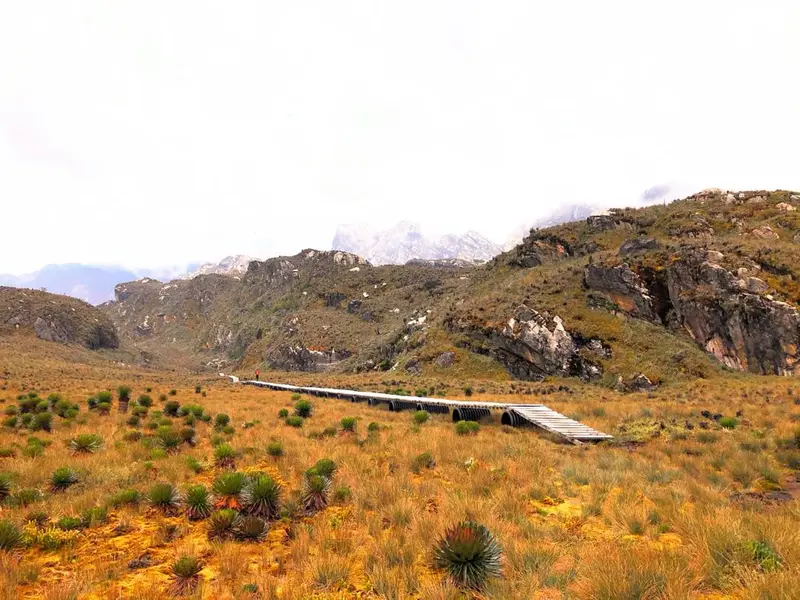Trekking Rwenzori Mountain
Introduction
The ancient geographer Ptolemy described the fabled “Mountains of the Moon” – snow-covered peaks rising from deep within Africa. In western Uganda, the legendary Rwenzori Mountains dominate the border of the west. Mist-shrouded summits, including Margherita Peak (5,109 meters) on Mount Stanley, Mount Speke (4,890 meters), and Mount Baker (4,843 meters), pierce the sky. Glaciers gleam under the equatorial sun, while valleys hide pristine lakes and harbor unique wildlife like the three-horned chameleon. Have you ever dreamt of standing atop a glacier in Africa?
The Rwenzori Mountains offer breathtaking views, diverse trails, and the chance for once-in-a-lifetime encounters. Experienced guides can lead you to icy summits or through lush valleys teeming with life. Whether it’s your first major trek or you’re seeking a new challenge, the Rwenzoris are easily accessible and offer unforgettable experiences. Hikers rave about the stunning scenery, walking the trails with friends, and the sheer thrill of exploring such a remarkable place.
This guide contains the best routes, essential gear advice, and all the practical details for a self-planned journey. Adventure awaits in the Mountains of the Moon!
The Rwenzori Peaks in Uganda
The heart of the Rwenzori Mountains is a realm of snow and ice, a starkly beautiful contrast to the lush lower slopes. Six massifs rise within the range, each harboring breathtaking peaks. Here’s a glimpse of the major summits awaiting intrepid climbers:
- Mount Stanley: The crown jewel of the Rwenzori Mountains. It boasts several peaks:
- Margherita Peak: Africa’s third-highest summit at 5,109 meters.
- Alexandra Peak: Slightly lower at 5,091 meters.
- Several other peaks top 5,000 meters, offering technical challenges.
- Mount Speke: To the south of Stanley, Mount Speke boasts four prominent summits:
- Vittorio Emanuele (4,890 meters)
- Ensonga (4,865 meters)
- Johnston (4,834 meters)
- Trident (4,572 meters)
- Mount Baker: East of Stanley, its highest peak reaches 4,843 meters. This massif offers both challenging routes and a stunningly beautiful glacial plateau.
- Mount Emin: Further north, its highest summit is 4,798 meters.
- Mount Gessi: Also to the north, Gessi’s peak sits at 4,715 meters.
- Mount Luigi di Savoia: This peak reaches 4,627 meters.
These glacial peaks define the Rwenzori experience. Standing atop any of them is a testament to human grit and offers views unparalleled anywhere else in Africa. However, the Rwenzori Mountains aren’t just about conquering summits – even those less focused on peak-bagging will discover a captivating world of alpine beauty between these giants.
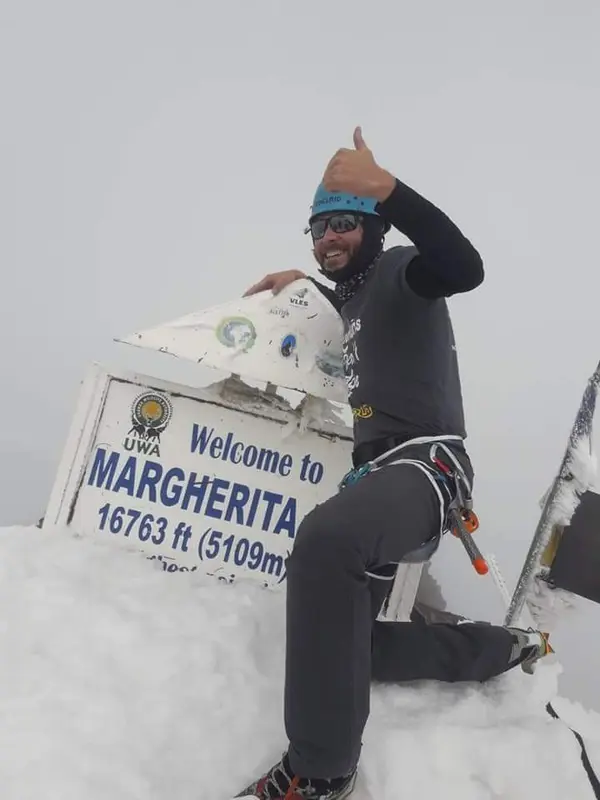
Trekking in the Rwenzori Mountains
The Rwenzori Mountains are a true explorer’s destination. Exploring them on foot is the only true way to experience their magic, but it demands commitment. Expect challenging hikes and endurance treks ideal for fit adventurers. While Margherita Peak now requires technical climbing experience, there are still diverse trails to suit varied interests, from determined peak-baggers to dedicated birders seeking the region’s unique species.
Treks here range from one to twelve days, and even private groups can extend routes for better acclimatization or to simply savor the otherworldly beauty longer.
Rwenzori Trekking routes
Two legendary circuits lead adventurers into the Rwenzori Mountains:
- The Central Circuit (Nyakalengija): This is the historic path favored for many years, following in the footsteps of Luigi di Savoia (1906).
- The Southern Circuit (Kilembe): This route, first explored by Professor Scott Elliott (1895), offers the most spectacular landscapes and longer routes, aiding with acclimatization. [Note: If your guide specializes in this, emphasize it here!]
Unlike single-peak treks like Kilimanjaro, the Rwenzori Mountains offer a true mountain range experience with a variety of routes. This is a major advantage, as longer treks (ranging from 2-12 days) allow for better acclimatization and reduce the risk of altitude sickness.
Here’s how the Rwenzori Mountains can fit into your Uganda safari adventure:
Short treks in the Rwenzori Mountains
The Rwenzori Mountains are remarkably close to Queen Elizabeth and Kibale Forest National Parks. The gateway city of Kasese is also easily reached from Entebbe, Kampala, or even Murchison Falls National Park. This makes it the perfect spot for breathtaking 2-5-day treks to complement your wildlife safari. Here are a few samples for you:
- 2-Day Lower Altitude Hike (up to 2,596 meters)
- 3-Day Hike (reaching 3,174 meters)
- 4-Days to Mutinda Lookout (3,975 meters)
- 4-Day Waterfall Hike (up to 3,174 meters)
- 5-Day Climb to Weismann’s Peak (4,620 meters)
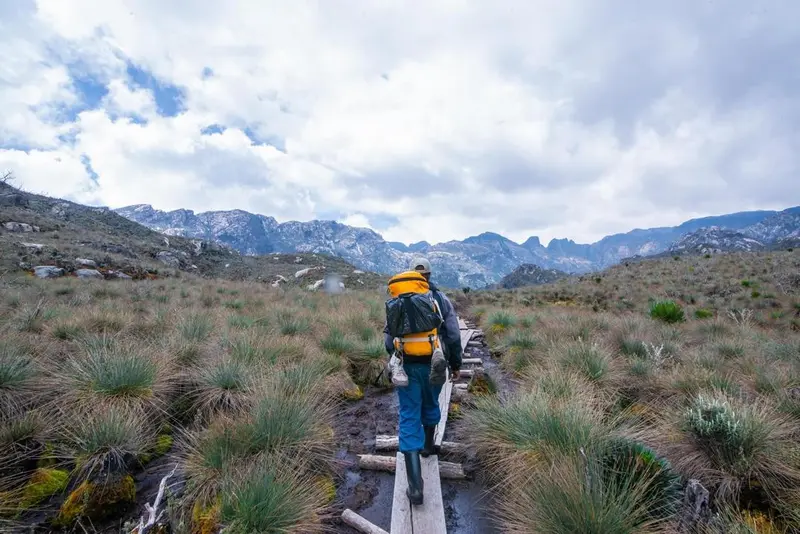
The challenging treks in Rwenzori Mountains
Ready for a true high-altitude adventure? If you’ve trekked before and yearn for a unique challenge, the Rwenzori Mountains offer some of the world’s most spectacular (and demanding) hikes. We’ve explored countless mountains, and these routes rank among the best.
The Crown Jewel: Margherita Peak (5,109 meters)
This summit, Uganda’s highest, demands respect. You’ll cross glaciers – one of only three places in Africa where you can! – using technical gear like crampons, ropes, and belays. Don’t be intimidated: our local guides are experts, and our success rate for summit hikes is an incredible 98%. With determination and fitness, you can conquer the Rwenzori’s icy heights.
More High-Altitude Routes
Margherita Peak isn’t the only challenge! Here are some popular options (remember, Margherita requires at least 7 days to acclimatize):
- 7-Day Climb: Mount Baker (4,842 meters)
- 10-Day Rwenzori Challenge: Summit four peaks, including Margherita (5,109 meters)
- 10-Day Margherita Peak Expedition
- 12-Day Ultimate Rwenzori Trek: The complete experience (up to 5,109 meters)
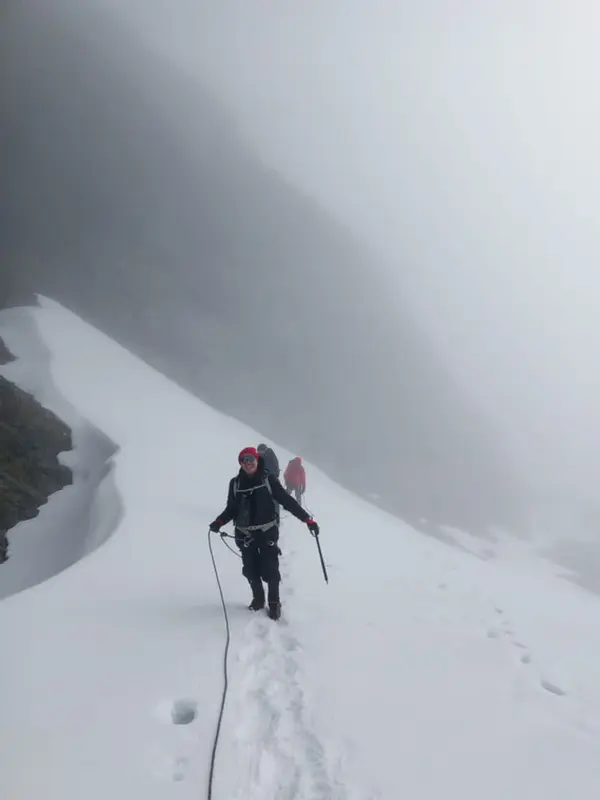
Planning your own Rwenzori trek route
While Rwenzori Mountains National Park perfectly complements other Ugandan adventures, they deserve to be a highlight all on their own. Many adventurers come to Uganda solely for the chance to explore these legendary peaks. And for good reason! Even locals and expats escape to the Rwenzori Mountains for thrilling weekend getaways.
If the Mountains of the Moon are calling your name, there’s a trek tailored to your goals. Whether you’re short on time, seeking extreme challenges, or longing for diverse landscapes, there’s a perfect route waiting.
Let our team help you craft the ideal Rwenzori itinerary. We’ll factor in your fitness, interests, and time constraints to create an experience you’ll never forget.
What to pack, wear, camping and safety equipment
Trekking Kit for Lower Rwenzori Altitudes
- Clothing:
- Base Layers: Light T-shirts/shorts for warm weather, warm long-sleeved shirts for evenings and higher elevations.
- Mid-Layers: Fleece jacket for warmth (or a lightweight down jacket if it gets truly cold).
- Outerwear: Lightweight raincoat/poncho and waterproof trousers for mountain showers.
- Accessories: Warm hat for evenings, a sun hat for the day, and gloves.
- Footwear:
- Hiking Shoes: Good-quality boots are ideal, but sturdy trainers can work for short, low-altitude hikes.
- Socks: Several pairs of warm, thick socks – comfort is key!
- Rubber Boots (Children): These are provided for adults, but kids will need their own.
- Equipment
- Sleep: Warm sleeping bag (at least a 4-season rating)
- Bags: Large, soft bag for porters to carry, and a daypack (at least 8 kg capacity) for your water, lunch, and layers.
- Weather Protection: Waterproof covers for your bags, or lots of plastic bags to keep things dry.
- Essentials: Lip balm, torch/headlamp with extra batteries, 3-liter water bottle(s), treatment tablets/filter (optional).
- Extras: Small towel, basic first aid kit, and some of your favorite energy-boosting snacks.
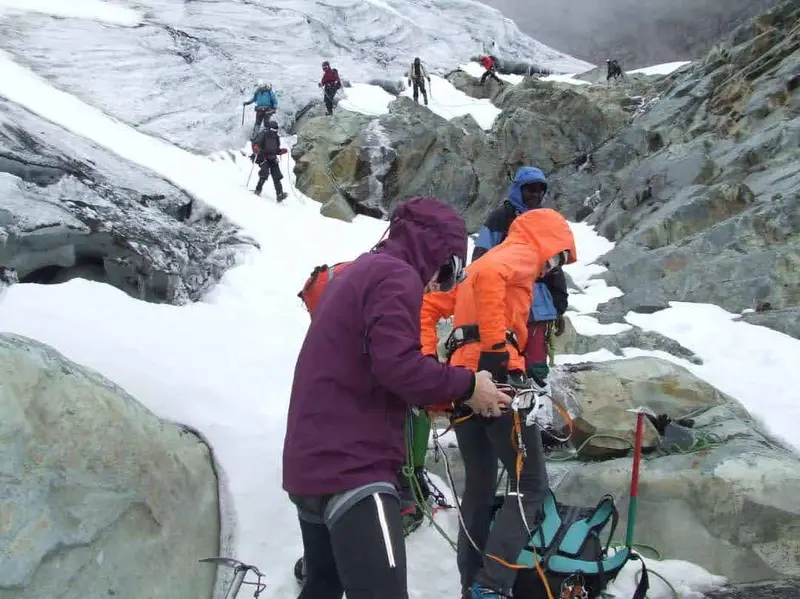
Kit List for Trekking Rwenzori Mountains High Altitude
- Clothing:
- Base Layers: Same as low altitude, plus thermal underwear for extreme cold.
- Mid-Layers: Warm fleece layers, and/or a down jacket for when temperatures drop.
- Outerwear: High-quality waterproof and windproof jacket and trousers. An additional plastic poncho or rain jacket/pants never hurts!
- Accessories: Include all accessories from the low altitude list and bring two pairs of gloves – thin liners and a warm/waterproof set.
- Footwear:
- Boots: Sturdy, well-worn-in mountain boots are non-negotiable.
- Camp Shoes: Lightweight shoes/trainers for the start of the trek and around camp.
- Socks: Plenty of warm socks for dry, happy feet.
- Crampons: Bring your own, ensuring they fit your boots!
- Equipment:
- The Basics: Same as low altitude, with an even warmer sleeping bag.
- Sun Protection: Sunglasses (side shields are best) and lip salve.
- Extras: A backup torch with spare batteries adds a layer of safety.
Key Points:
- Layering is key: Mountains change their minds about the weather quickly! Pack light layers you can add or shed. Think warm base layers, a fleece, and a waterproof shell to start. You’ll thank yourself later.
- Happy feet, happy hiker: Blisters from bad boots can ruin a trip. Break in your boots well, and pack enough thick socks to keep your feet dry and comfortable. Your bag should also feel good on your back; ask your guide for advice if you’re unsure about that.
- The “better safe than sorry” rule: Extra batteries for your headlamp, an extra rain jacket… these things weigh little but can make a BIG difference if something unexpected happens.
- Make it yours: Those little energy bars or trail mixes you love? Toss some in your pack. They give a boost when you need it, both physically and mentally!
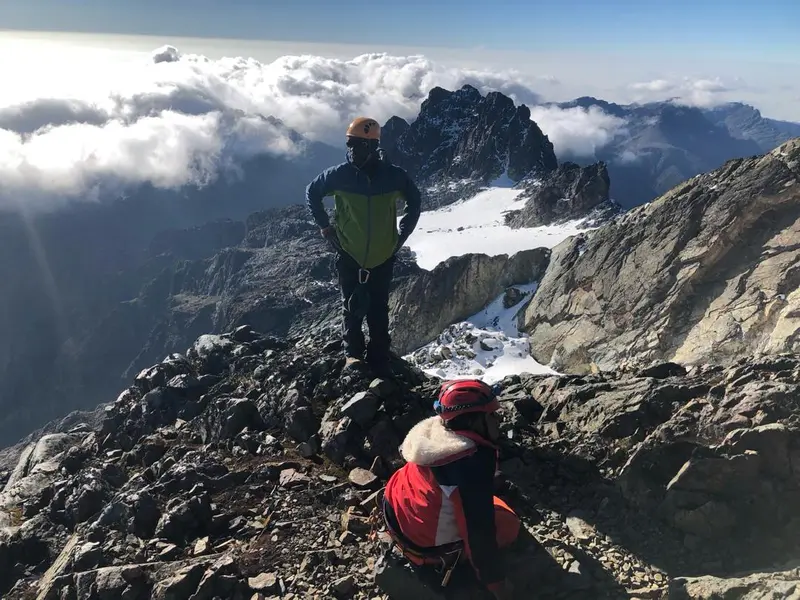
Best time to visit Rwenzori mountains in Uganda
- Aim for the Drier Seasons: June to early September and late December through February tend to see less rainfall. Daytime temperatures at lower elevations can range from comfortable (15-25°C) to quite warm (25-30°C), dropping significantly at night. Higher up, expect it to be chilly even in these seasons. Snow and ice are always present on the peaks.
- The Wet Seasons: Don’t rule out other months! While there’s more rain lower down, with temperatures similar to the dry season, the higher reaches get more snow, creating that magical, ice-covered landscape unique to the Rwenzori Mountains. If you’re prepared for the wetter weather, this can be an incredibly rewarding time to trek in the Rwenzori Mountains.
- Flexibility is Key: Rwenozro Mountains weather is unpredictable. Even in drier months, prepare for showers and chilly temperatures. A good outfitter will advise on what to pack no matter when you go.
- Your Goals Matter: Headed for the highest peaks? Snow and ice conditions change throughout the year. Discuss your ideal experience with our guides to find the season that aligns best with your objectives.
The Bottom Line: There’s no truly bad time to trek the Rwenzori Mountains. Each season offers its own unique experience. Be prepared, be flexible, and get ready for an unforgettable adventure!
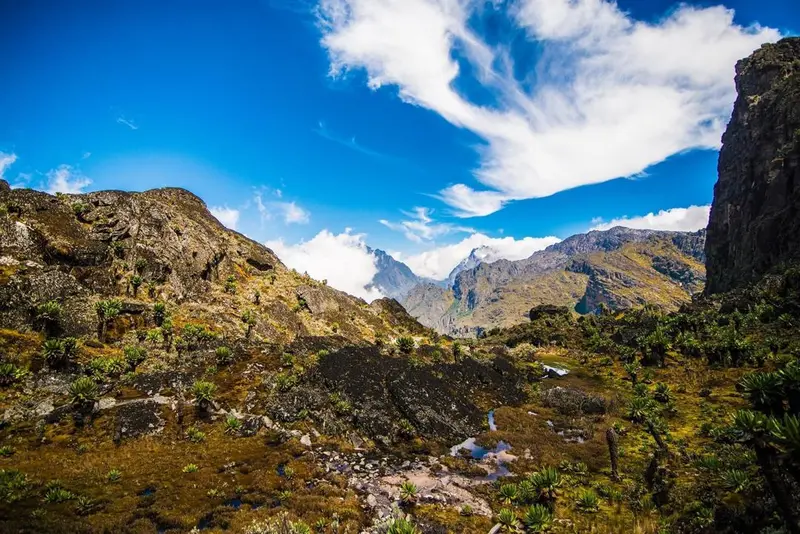
Geography, Fauna and Flora of Mt Rwenzori in Uganda
Geography & Geology
The Rwenzori Mountains are a spectacle born of immense forces. Three million years ago, tectonic movements thrust ancient rocks skyward, creating a 120-kilometer-long, 65-kilometer-wide range along the border with the DRC. Unlike solitary volcanoes, these mountains were forged from the earth, making them Africa’s largest range.
Though straddling the equator, the Rwenzoris’ six majestic peaks – Stanley (5,109m), Speke (4,890m), and Baker (4,843m) – defy the heat. They harbor permanent glaciers, a dazzling contrast against the surrounding greenery.
This abundance of snow and rain, exceeding 3 meters annually, sustains the mountains’ lifeblood. Muddy trails and over 20 beautiful lakes, like the eight strung along the Kilembe Trail, were carved by ancient glaciers. Countless rivers and streams flow from these heights, carrying life to the plains far below.
Flora
The Rwenzori Mountains offer far more than stunning views; it’s the vibrant plant life that leaves a lasting impression. Here, moisture reigns, temperatures remain mild, and life explodes in dramatic forms. Giant lobelias, vast carpets of heather, and vibrantly colored mosses paint an otherworldly scene unique to these mountains.
Your trek in the Rwenzori Mountains will be a journey through five distinct vegetation zones:
- Afro-montane Forest (1765m – 2600m): A teeming jungle of ancient trees and dense undergrowth.
- Bamboo Zone (2600m – 3000m): Towering bamboo stalks and a thick layer of leaves create a calm atmosphere.
- Heather Zone (3000m – 3800m): Sphagnum moss, otherworldly lichens, and bursts of pink orchids carpet the ground.
- Moorland (3800m – 4500m): Home to the iconic giant groundsels and torch lobelias.
- Rocky Glacier (4500m+): Only the hardiest mosses, lichens, and “Everlasting” plants survive.
Fauna
The Rwenzoris’ diverse vegetation zones harbor a rich variety of life, including 70 mammal species and a staggering 177 bird species. Spotting the larger mammals—elephants, chimpanzees, the rare Rwenzori otter, and even leopards—is a challenge due to the thick foliage, but it adds to the thrill of discovery.
Your best chance for wildlife encounters is with the primates. Look for colobus monkeys (both Angolan and black-and-white), the playful blue monkeys, and smaller antelope like the bushbuck. Keep an eye on the forest floor for the bizarre and fascinating three-horned chameleon!
The Rwenzori Mountains are a birdwatcher’s paradise, particularly due to the presence of Albertine Rift endemics, making them an Important Birding Area (IBA). The montane forest teems with life: Rwenzori Turacos, Barred Long-tailed Cuckoos, Long-eared Owls, Handsome Francolins, Cinnamon-chested Bee-eaters, and many more. You might even spot Archers’ Robin-chats, White-starred Robins, Rwenzori Batis, Montane Sooty Boubous, Lagden’s Bush Shrikes, Slender-billed Starlings, Blue-headed Sunbirds, Golden-winged Sunbirds, Strange Weavers, and a dazzling array of Barbets, Greenbuls, Apalises, IIladopsis, Flycatchers, and Crimsonwings.
Don’t forget to scan the skies! High above, majestic lammergeiers and black eagles patrol the peaks.
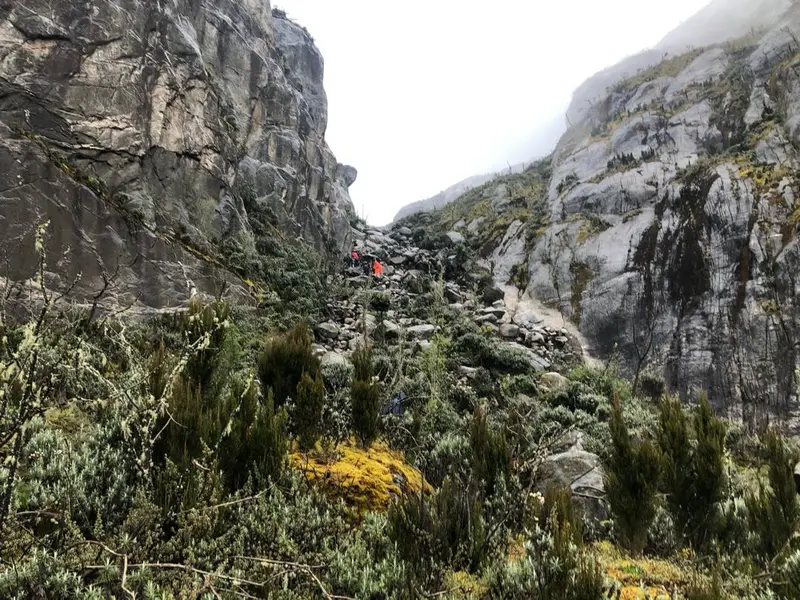
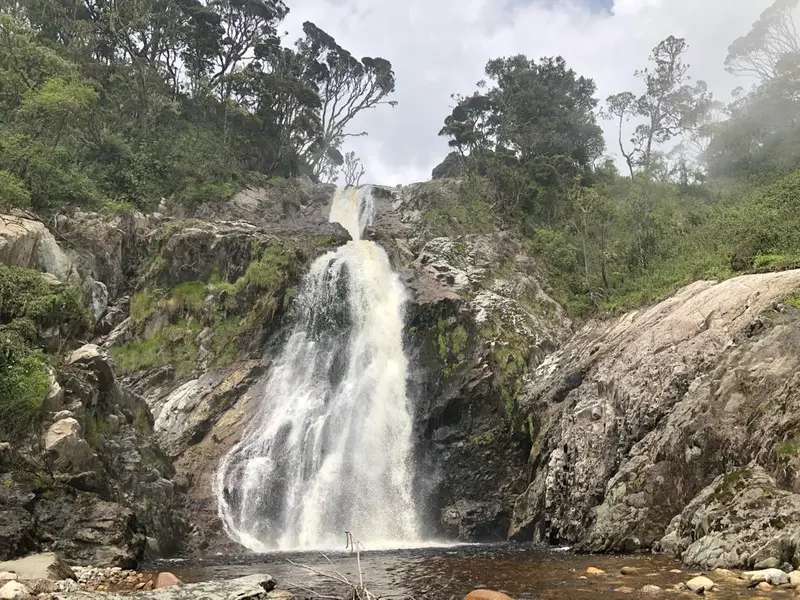
How to get to Rwenzori, the mountains of the moon
- By Air: This is the quickest route! Daily flights from Entebbe take just over an hour. If you prefer to fly into Kasese directly, there are flights departing Entebbe at 7 am and 12:30 pm daily. The return flight leaves Kasese at 10:45 am and 2:45 pm daily. Flight time is about 1 hour.
- By Road:
- Scenic Drive: A 6-8 hour trip from Entebbe/Kampala via Fort Portal offers beautiful views.
- Budget Option: Public buses depart Kampala hourly and cost around 50,000 UGX (~$14 USD). We recommend Link Bus or Kalita Transporters. From Kasese, taxis to Kilembe cost ~40,000 UGX. Total travel time is about 10 hours.
Where Your Trek Begins: All Rwenzori treks start at Trekkers Hostel Kilembe (aka Rwenzori Backpackers Hostel Kyanjuki), 12km from Kasese (a 30-40 minute drive). Guides will brief you at 8:00 am.
Convenient Connections:
- From Queen Elizabeth National Park: About an hour away.
- From Bwindi Impenetrable National Park: Allow about six hours of travel time.
Let Us Handle the Logistics: If you book with us, we’ll arrange all your transfers, so you can focus on the adventure!
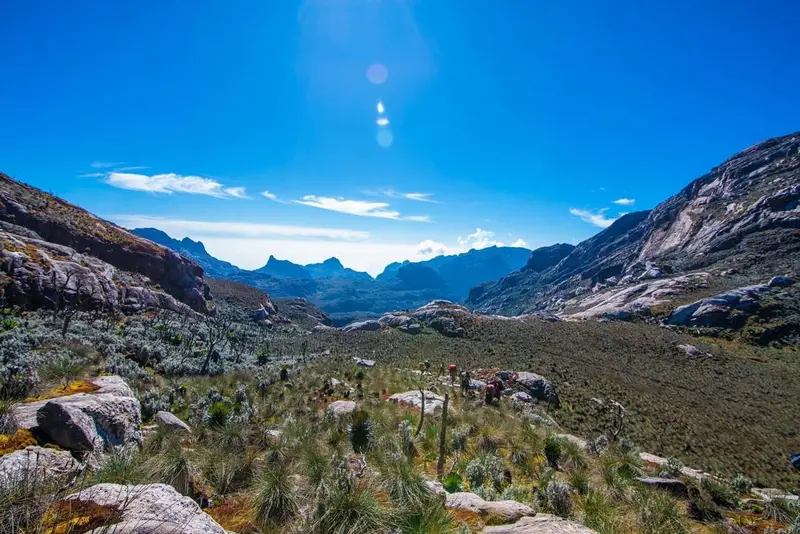
Trekking Camps in Rwenzori Mountains
Samilira Camp (3,170m)
Nestled in the Montane Forest zone, Samilira Camp offers views of Kilembe, Queen Elizabeth National Park, and Lake George, along with the surrounding mountains. It has three cabins – two with 8 bunk beds each, and one with 3 single beds. Toilets are long-drop and located outside the sleeping huts. Bucket showers are available, and water can be heated for a touch of warmth. Just above the camp, you’ll find a lovely Lobelia garden. Unfortunately, there’s no electricity at Samilira.
Kiharo Camp
Located in the Heather zone, Kiharo Camp boasts panoramic views of the Nyamwamba Valley and the imposing Twin Peaks. It has four cabins: three with 8 bunk beds each, and one with a double bed for couples. Long-drop toilets are outside the sleeping huts, and bucket showers are available (water can be heated). Kiharo is a birdwatcher’s delight, with the Rwenzori Turaco often sighted, and there’s a beautiful waterfall just 20 meters away. A Lobelia garden lies on the approach to the camp. Bonus: solar panels offer basic electricity for charging devices.
Mutinda Camp (3,588m)
Straddling the Heather and Afro-Alpine zones, Mutinda Camp provides breathtaking views of Mulyambuli Valley and the Mutinda lookout. You’ll find three cabins here, each fitted with 8 bunk beds. Toilets are long-drop and outside the huts, and bucket showers are available with water heating. The views from Mutinda lookout are a highlight, and the surrounding peaks have never been summited! There’s no electricity at this camp.
Kalalama Camp (3,134m)
Set amidst the Heather zone, Kalalama Camp treats you to vistas of Kilembe town, parts of Queen Elizabeth National Park, Lakes Edward and George, as well as peaks like Rutamaguvu and Mutinda lookout. Here, there are two cabins; one features 8 bunk beds, the other has 3 single beds. Toilets are the long-drop variety located outside the huts, and bucket showers with water heating are provided. Look out for the large heather trees surrounding the camp. Kalalama offers solar panels for basic charging needs.
Sine Hut (2,596m)
Tucked within the Montane Forest Zone, Sine Hut’s views are somewhat restricted by the dense tree cover. However, you can catch glimpses of the meandering Mulyambuli River. There are four cabins here, mostly with 8 bunk beds, and one with 10. Long-drop toilets are outside the huts, and bucket showers are available (water can be heated). A short walk away are the beautiful Enock Falls. Solar panels provide basic lighting at Sine Hut.
Bugata Camp (4,062m)
Situated high in the Afro-Alpine zone, Bugata Camp rewards trekkers with sweeping views of the Nyamugasani Valley and its glacial lakes. You can also spot peaks like Keki and Mount Luigi di Savoia from here. The camp has two cabins, each equipped with 8 bunk beds. Toilets are long-drop, located outside the huts, and bucket showers are available with water heating. Nearby lies the picturesque Bugata Lake. There is no electricity at this camp.
Butawu Camp & Hunwick’s Camp (3,974m)
Both of these camps reside in the Afro-Alpine zone. They offer views of the Butawu Valley leading to Kitandara, as well as peaks like Mount Luigi di Savoia, Mount Baker (with its glaciers), and even glimpses of Mount Speke on clear days. Each camp has three cabins – two with 8 bunk beds, and one with 4 singles. Long-drop toilets are outside the huts, and you can enjoy bucket showers with water heating. There’s nothing of particular interest in the immediate area, but solar panels provide basic charging for devices.
Margherita Camp (4,485m)
Set high in the Alpine zone, Margherita Camp offers incredible views down the Kitandara Valley, including the Kitandara Lakes. Peaks like Weismann’s, Elena, and Mount Speke are visible from here. It has four cabins, mostly with bunk beds, but a few singles are available. Toilets are long-drop, located outside the huts, and bucket showers are available with water heating. The views of the glaciers at Elena Peaks, as well as glimpses of Mount Speke and Margherita Peak, are truly spectacular. Solar panels provide basic charging at this camp.
Important Note
Conditions in all the Rwenzori camps are basic but comfortable. A warm sleeping bag is an absolute must for a good night’s rest. After those long days of trekking, a hot shower feels incredibly luxurious – remember that hot water is provided at the camp’s discretion. Solar power availability is limited throughout the Rwenzori Mountains, so make sure to bring plenty of backup batteries for your essential devices.
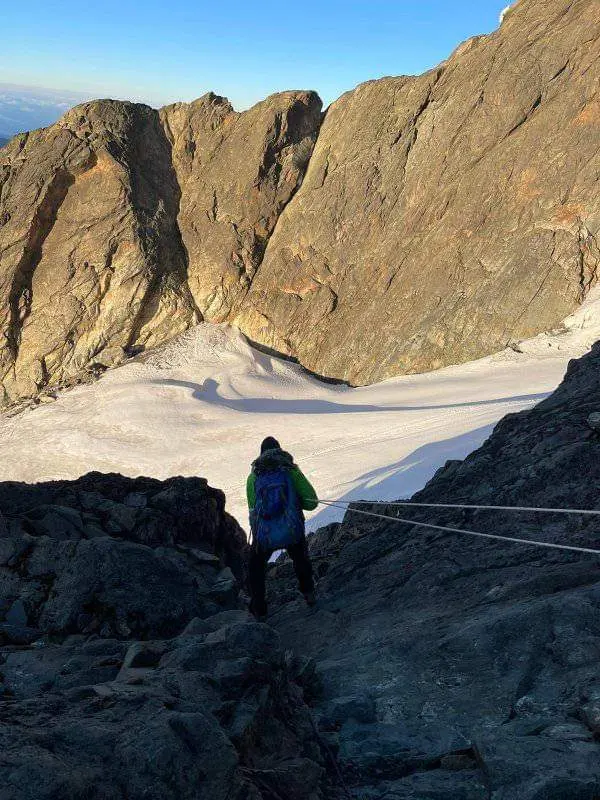
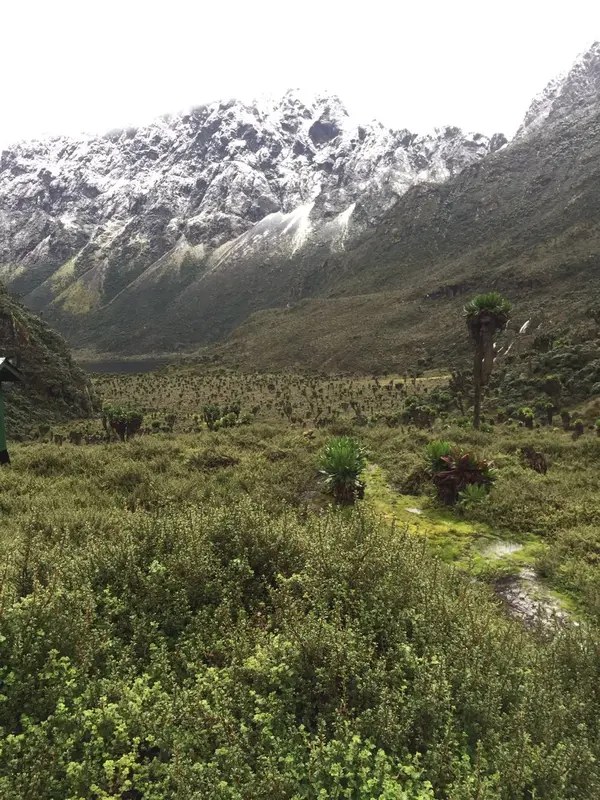
Accommodation Outside Rwenzori National Park
Community-Focused Stays
Ruboni Community Camp: Nestled in the Rwenzori foothills near the park gate, this camp offers a unique cultural experience. Owned and managed by the Bakonzo people, it’s ideal for those wanting to explore local villages and hills before or after their trek. Traditional dance performances, stories, and overnight hill treks enrich the experience.
Rwenzori Turaco View Campsite: Located in Mihunga Village, this community-run campsite features rooms with mosquito nets and bathrooms. You can immerse yourself in local life with activities like hiking, birdwatching, and village walks.
Mid-Range Comfort
Geolodge Equator Snow Lodge: Positioned near the park’s gateway, this lodge caters to both seasoned and first-time mountaineers. Collaborating with the Ruboni Community and Rwenzori Mountaineering Services, they offer guided mountain adventures for various skill levels. Enjoy comfortable rooms, some accommodating up to four guests.
Rwenzori Basecamp—Tours Holiday Inn: This hotel is just a short distance from Nyakalengija. It boasts self-contained rooms, beautiful gardens, and a cozy dining area. The rates are budget-friendly, making it a great value choice.
Other Notable Options
Rwenzori Trekkers Hostel (Kilembe Trail): The starting and ending point for Kilembe Trail treks, this hostel offers camping, dorms, and private rooms amidst stunning views of the Nyamwamba River and the Rwenzori Mountains.
Hotel Margherita (Kasese): Conveniently located for accessing multiple national parks, this hotel features spacious rooms with private balconies offering mountain, garden, or golf course views. Family rooms are available.
Additional Lodges: Other options within the region include the Bunga Community Tourism campsite, Rwenzori International Hotel, and Tropical Savannah Guest House.
Important Note: When choosing accommodations, consider your desired level of comfort, proximity to the park entrance, and any additional activities or cultural experiences you might be interested in.
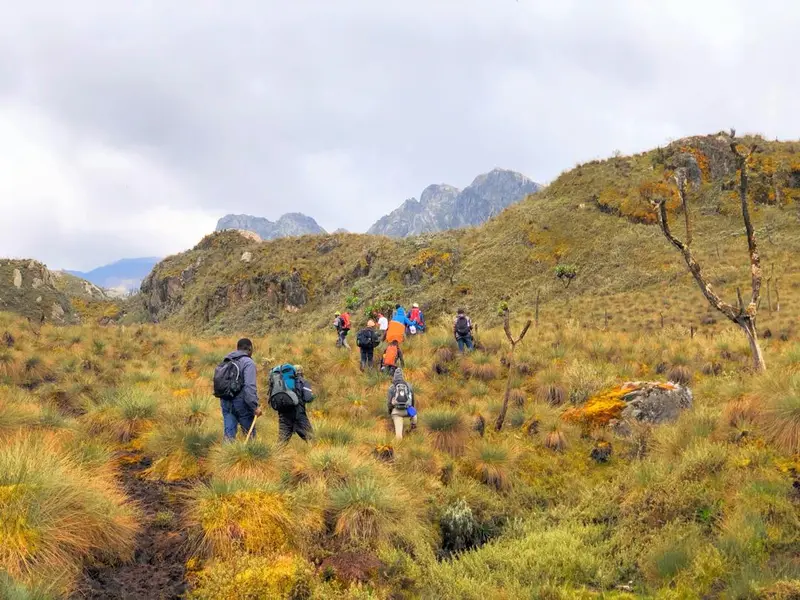
Costs for Trekking in The Rwenzori Mountains
The cost of hiking the Rwenzori Mountains depends on several factors, including your chosen route, the length of your trek, and the number of peaks you wish to summit. It’s important to note that prices listed here often exclude personal gear rental.
Central Circuit Trail Costs
This popular route includes park guides, porters, food, park entrance fees, accommodations, climbing equipment, and more. Remember, additional peaks cost $100 each, and each extra day in the mountains costs $150.
Here’s a general breakdown:
7 days Central Circuit with Margherita Peak
Foreign Non-Residents – $1350,-
East African Resident – $1100,-
Ugandan – $550,-
8 days Central Circuit with Margherita Peak + 1 additional peak
Foreign Non-Residents – $1800,-
East African Resident – $1100,-
Ugandan – $550,-
9 days Central Circuit with Margherita Peak + 2 additional peaks
Foreign Non-Residents – $1950,-
East African Resident – $1100,-
Ugandan – $550,-
6 days Central Circuit without Margherita Peak
Foreign Non-Residents – $1250,-
East African Resident – $900,-
Ugandan – $400,-
5 days Multiple Peak Options Available
Foreign Non-Residents – Varies
East African Resident – Varies
Ugandan – Varies
3-4 days Shorter Treks (Mahoma Loop, John Matte)
Foreign Non-Residents – Varies
East African Resident – Varies
Ugandan – Varies

Kilembe Trail Costs
This route also includes porters, food, guides, and mountain accommodations. Equipment rentals are separate. Prices vary with length and included peaks.
8 days Kilembe with Margherita Peak
Price per Person (1-2 persons) – $1360,-
Price per Person (3+ persons) – $1280,-
7 days Kilembe with Margherita Peak
Price per Person (1-2 persons) – $1360,-
Price per Person (3+ persons) – $1280,-
9 days Kilembe + Margherita + 2 other peaks + Weismann's
Price per Person (1-2 persons) – $1520,-
Price per Person (3+ persons) – $1450,-
10 days Kilembe + Margherita + 3 other peaks + Weismann's
Price per Person (1-2 persons) – $1660,-
Price per Person (3+ persons) – $1580,-
5-7 days Shorter Treks to Weismann's Peak or Mount Baker
Price per Person (1-2 persons) – Varies
Price per Person (3+ persons) – Varies
2-4 days Shorter Forest Treks
Price per Person (1-2 persons) – Varies
Price per Person (3+ persons) – Varies
Important Notes:
- These prices usually exclude gear rentals (sleeping bags, jackets, etc.) and the UWA gate entrance fee ($35 per person per day).
- Reputable tour operators like Rwenzori Mountaineering Service can assist with bookings and payments.
- Consider combination tours! A 12-day Rwenzori + Gorilla + Queen Elizabeth safari might be around $3800 (2 people) or $4500 (single traveler).
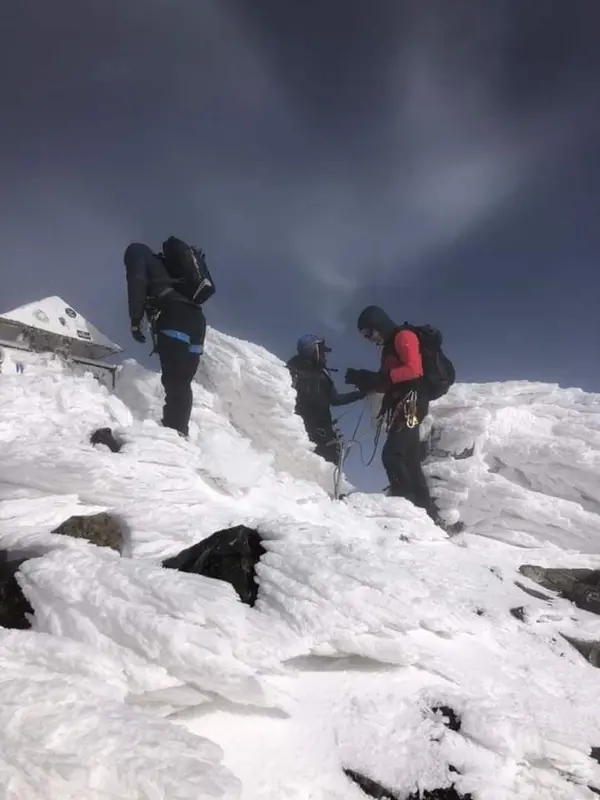
Frequently Asked Questions (FAQs)
Equipment
All technical gear (ropes, ice axes, crampons, etc.) is high-quality and imported from the UK. While bringing your own crampons is recommended, rentals are available. For Margherita Peak summits, harnesses, carabiners, ice axes, helmets, rubber boots, ropes, and ice screws are provided. Sleeping bags can be hired (though not new), or you can bring a sleeping liner.
Is there electricity in the camps?
Yes, Sine, Kalalama, Hunwick’s, Kiharo, and Margherita camps have solar power for lighting and charging devices. Forest View Camp only has exterior solar lighting. Camp facilities are continuously being improved as funds from treks are reinvested.
How is drinking water handled on the mountain?
All drinking water comes from fresh streams and must be purified. Bring purifiers capable of handling at least 3 liters per day. We also boil water nightly for teas and coffee, which you can use to refill your water bottle.
Food & Logistics
Meals are designed to be nutritious and cater to allergies. Pro-tip: bring your favorite snacks for a boost on the trail! Here’s a sample of the foods served:
- Dinner: Rice, Irish potatoes, pasta, noodles, pumpkin, meat, mixed vegetables, chicken, spaghetti, cheeses, soups
- Breakfast: Eggs, sausages, bacon, potato patties, breads, porridge, teas, coffee, hot chocolate, pancakes, baked beans on toast
- Lunches: Various sandwiches, juice, salads, vegetables
Are there mosquitoes in the Rwenzori Mountains?
No, the high altitude conditions mean there are no mosquitoes. However, it’s still wise to bring insect repellent just in case.
What is the accommodation like during the trek?
All accommodation is in dormitory-style huts with bunk beds and mattresses. Efficiency is prioritized, so private rooms are not available. Bring a good 4-season sleeping bag.
Do treks run in groups or privately?
We offer both group and solo treks. Book any date, and your trek will be private if no others are scheduled. Group sizes are capped for your comfort and safety.
Altitude & Location
Yes, it’s possible on high-altitude treks (those reaching peaks above 4,000m). The Rwenzoris’ routes allow for longer acclimatization compared to some other mountains. For Margherita Peak, we recommend 8+ day routes to reduce altitude sickness risk. Talk to us if you have concerns.
Where are the Rwenzori Mountains located?
The Rwenzori Mountains are located in southwest Uganda, bordering the DRC. They are one of only three places in Africa with permanent glaciers (though these are sadly receding). The range is close to Kibale National Park, known for chimpanzee trekking, and Queen Elizabeth National Park, known for lions and big game safaris.
Why are the Rwenzoris called the Mountains of the Moon?
This ancient name has been used for centuries, appearing on old maps and in the writings of geographers seeking the Nile’s source.
Are the Rwenzori Mountains the highest mountain range in Africa?
Yes! The highest point is Margherita Peak on Mount Stanley, at 5,109 meters. Other notable peaks include Mount Baker (4,842m), Mount Speke (4,890m), and Weismann’s Peak (4,620m).
